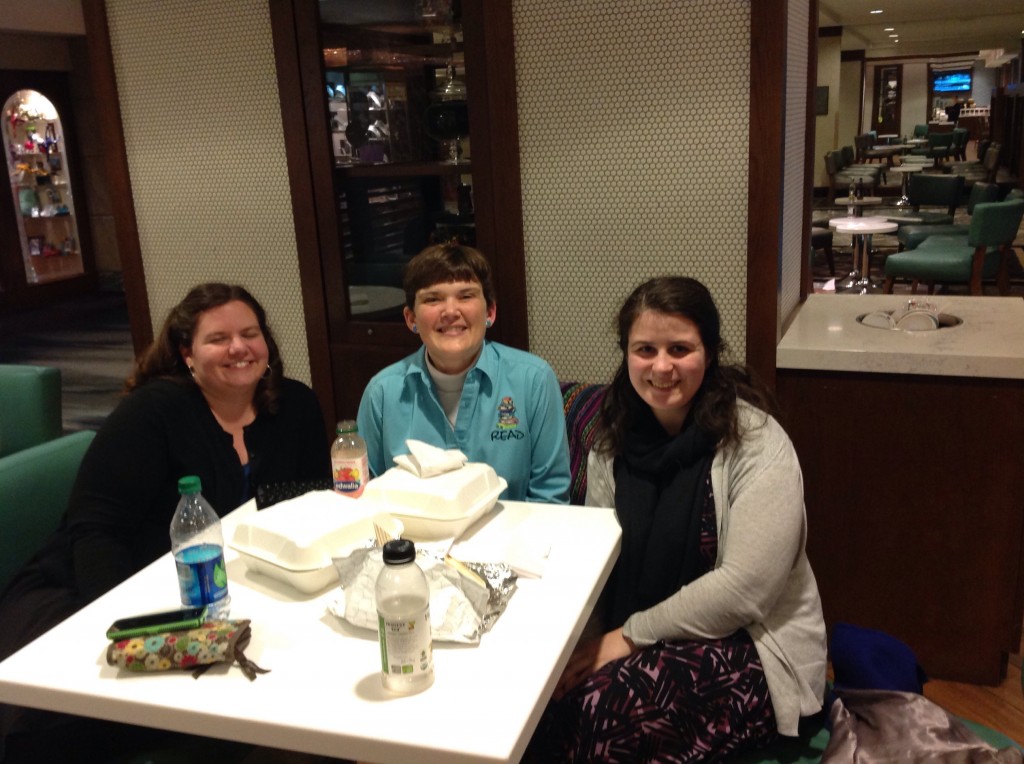ALA Annual Conference: Reading the Art in Caldecott Books
Reading the Art in Caldecott Award Books
What Makes a Picture Book Distinguished?
Gail Nordstrom
Coordinated Mock Newbery and Caldecott discussions
2002 Newbery committee, 2011 Caldecott committee
Heidi Hammond
School Librarian
Appointed to 2011 Caldecott committee
You must be a member of ALSC, and you must volunteer!
Wrote a book: Reading the Art in Caldecott Award Books: A Guide to the Illustrations
“Nothing happens accidentally in a picture book.” — K.T. Horning
The Adventures of Beekle, by Dan Santat
Notice: Dust jacket and book cover differ.
End papers have images — a variety of imaginary friends. Beekle’s purpose isn’t clear.
Color is important in Beekle. Full color in the imaginary world. Real world is dark and grim.
Playground is colored.
Beautifully balanced color in the tree.
Change of perspective. Detail, like tape on Beekle’s crown.
At the end, we learn Beekle’s purpose.
2014 Caldecott Medal: Locomotive
In this book, artistic expression as a whole.
Pen & Ink with water color — amazing detail.
Sense of speed. Tones give a sense of place and time.
There’s a second visual narrative in the illustrations.
Train has a diagonal line of energy. Great detail. Even bolts on the locomotive. Night scene. Coming right at you.
Font is used effectively.
Amazing end papers in this book.
Again dust jacket and boards have different images.
Elements of Art
Flora and the Flamingo: Color
Effective use of negative white space.
Line: Straight vertical line causes us to stop.
Molly Idle was an animator before illustrator — flaps add motion.
Diagonal line suggests movement.
Tree branches add balance
Color does evoke feeling and mood.
Creepy Carrots has a totally different feel.
Also minimal colors in One Cool Friend and use of white space.
Patterns used consistently.
This One Summer
Also minimal use of color. Indigo gives us a nostalgic feel.
Multiple images to suggest movement.
A variety of page and panel layouts.
Creative Spirits
Viva Frida — A new kind of art. Stop motion puppets, paint, photography, digital manipulation
Color is vibrant and intense.
Much texture
Begins with puppets and evolves into a dream world of acrylic paints.
The Right Word — collage and water color
Interesting shapes right from the start
Focus of each page is on a book cover
3D collage — lots of texture.
End papers goes from cluttered to ordered
The Noisy Paint Box
Expressionistic art — acrylic paint and paper collage.
Starts formal – art explodes with emotion later
Text becomes part of the illustrations
Dave the Potter
Light streams down on him.
Collage elements cut out of glossy photographs
Element of shape — roundness as he creates the bowl
Journey, by Aaron Becker
Different perspectives
Endpapers show different modes of transportation throughout the ages
Details of her room show her longing for travel
Me… Jane
Jane also makes a journey
Me… Jane is a circle story and first and last pictures reflect that.
Nana in the City
Vibrant colors
Spread before book begins lead to the city.
Grandma’s red accessories make her stand out.
Vignettes show action in quick sequence.
Page turn with boy marching right off the page.
They stand out from the crowd but blend in with the city.
Mr. Wuffles!
Water color and india ink
Layer upon layer to get the dimensionality of the cat.
Long thin panels with varying perspective
Mounted a camera to a broomstick to get a cat perspective
Color value change when we focus on the aliens. Different sense of space.
He worked with a linguist to develop a new language
Dust jacket and boards of books are totally different.
Sleep Like a Tiger.
Lots of pattern — acrylic paint on board, collage, digital manipulation.
Repeating motifs
Tiger is important
On moon, collage is the text of Tyger, by William Blake
Shape — rounded and comforting. Snail shape
Sam and Dave Dig a Hole
Shape is very important here, and negative/positive space
Colors change subtly as they dig.
Visual vertical motion where they fall.
This is Not My Hat
All hand-lettered
Horizontal format
In the sea, but grounded with the tops of plants.
The images tell a very different story than the narrative.
Clear movement across the page toward the page turn
Has the unusual movement “backwards”
Opposing narrative — completely different from the narrative
A Sick Day for Amos McGee
Blue end papers match blue of Amos’s house. Red letters match red of balloon. Horizontal line carries action through.
Flourish at end of each line, different each page.
Vertical lines cause us to pause.
Woodblock printing causes texture.
The animals aren’t humorous, but have dignity.
Text balances the image.
Amos is touching almost every animal in the story.
Now groups talk about picture books.























